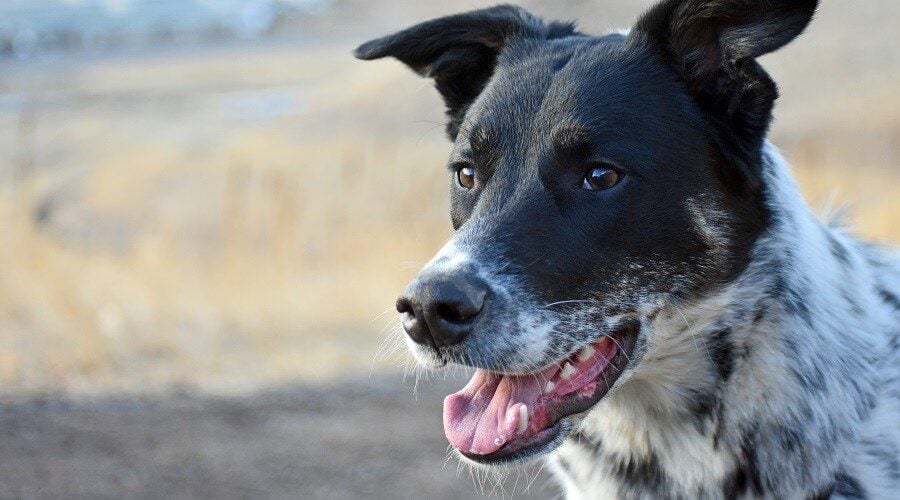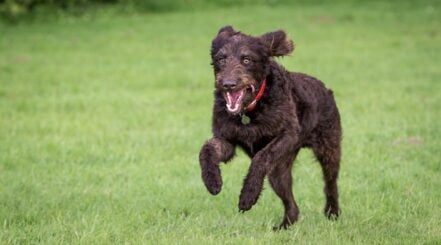They say opposites attract, and that couldn’t be truer than in the case of the Blue Heeler Lab Mix. The Labrador Retriever’s friendliness and trainability temper a Blue Heeler’s fiery intelligence to create a dog that is bright enough to learn any task and easy-going enough to want to learn it. This is certainly a case of two opposite breeds coming together to form one attractive mix.
To understand the success of the Blue Heeler Lab mix, one must understand the solid histories of its foundational breeds. Labrador Retrievers and Blue Heelers may have varied personalities, but they share a similar origin: they’ve loyally helped their owners through a rugged day of work for hundreds of years.
This means the Blue Heeler Lab mix is not only the ideal working dog but also, unfalteringly, “man’s best friend.” Let’s get to know the one and only Labraheeler.
Parent Breeds
Mixed-breed dogs can take after either parent. They inherit a mix of genes from each side and can display the physical, behavioral, and health characteristics and genetic traits of both parent breeds. To understand fully what your Blue Heeler Lab mix might be like, you should first meet the parents.
Labrador Retriever

Despite what the name suggests, Labrador Retrievers are not from Labrador at all. They were originally bred in Newfoundland in the 1500s. Originally known as the St. John’s Water Dog, they spent their days working on fishing boats. Their job was to retrieve fish that came off the trawl and pull in filled fishing nets. Their thick, water-repellent coats were uniquely suited for swimming in the North Atlantic’s icy waters, and their otter-shaped tail and webbed feet helped propel them through the water.
English aristocrats began the breed’s ascent to popularity in the early 1800s when they were discovered by British Earls and Dukes visiting Canada. They found the breed’s strong retrieving instinct and gentle manner ideal for fowl hunting. It was the English that mistakenly associated the dog’s origin with Labrador, referring to them as the Labrador Retriever, and the new name stuck.
By the end of the 19th century, the English had refined the breed so much that it was completely distinct from the St. Johns Water Dog and was considered an entirely separate breed.
The Labrador Retriever appeared in the United States in the early 1900s and grew in popularity with farmers and hunters. Today, Labrador Retrievers are still dedicated companions to hunters and fishermen. Labs are renowned for their easygoing and cheerful disposition. They are highly adaptable and easy to train and are also noted as being incredibly gentle.
Their trainability and gentle nature have made them an outstanding option for both family pets and public service. Authorities frequently employ Labradors for search and rescue or detection work. Labradors are also a popular choice for therapy and service dogs. They are a very popular breed that gets mixed with other breeds fairly often.
Blue Heeler

Blue Heelers, also known as Queensland Heelers or Australian Cattle Dogs, were developed in the 1800s, right as the English were discovering Labrador Retrievers. When Anglo-Australians migrated further inland from the coast of Australia, they found prime land for raising cattle.
However, the Smithfield Sheepdogs that were imported from Britain were poorly suited for the high temperatures, rough terrain, and sheer vastness of wild Australia. The Smithfield Sheepdogs were crossbred with Dingoes—a breed of wild dog native to Australia. This resulted in a hardy herding dog suited for the harsh terrain.
However, Blue Heelers did not get their trademark appearance until later, when Dalmatians and Kelpies were introduced into the bloodline. Dalmatians gave Blue Heelers their trademark speckles and an affinity for working around horses, which was important for ranchers. Kelpies introduced black-and-tan markings, extreme intelligence, and bravery around large animals like cattle.
The result was a hardy, intelligent herding dog adapted to long hours working in Australia’s challenging climate. Blue Heelers were pivotal to the development of Australia’s cattle industry, which played an important part in the early growth of Australia’s economy. Today, Blue Heelers are still popular dogs for farms and ranches due to their work ethic and herding instincts.
However, their high intelligence and courageous attitude can make training difficult. Blue Heelers are known to be stubborn and get bored easily.
Meet The Labraheeler
While crossbreeding can produce varied results in a dog’s temperament, a Blue Heeler Lab mix is sure to be fiercely loyal to their family and their work. The ideal Blue Heeler Lab mix will have the best of both breeds. They are both intelligent and eager to please, which allows them to be trained to do a multitude of complex tasks.
The Labraheeler is courageous and alert, keeping a close eye on their family while maintaining an easy-going nature around strangers. Blue Heeler Lab mixes are often brave and highly adaptable, making them excellent traveling companions. These hybrid pups retain some of the best traits of their parent breeds.
Temperament
The Blue Heeler Lab mix is one of the most friendly and hyper dogs you may ever meet. These pups are a handful and need to be with families that can match their energy. They are energetic, affectionate, smart, and very committed to their people.
With strong herding instincts, Blue Heeler puppies have a tendency for mouthy habits. Their protective instincts make them wary around strangers, so early socialization is a must for this mix. Blue Heelers are happiest when they are at their human’s side, but they can struggle with separation anxiety. However, with proper training, you won’t find a more dedicated companion.
Labradors are gentle and kind but also have a highly energetic streak. They can also be highly sensitive, so mixing in the Blue Heelers genetics creates a very agreeable yet needy pooch. They have tons of energy and lots of love to give, but be careful around small kids and elderly folks. This pup’s liveliness and size can become a bit of an issue if they get overexcited or don’t have enough outlets for all that energy.
Size & Appearance
Blue Heeler Lab mixes are very unusual-looking pups. Larbaheelers often have a silly look due to their ears. They can inherit pointy ears, floppy ears, or one of each. Their eyes are round and expressive, with Labrador-like snouts. Lab Blue Heeler bodies are strong and athletic.
I often hear the question, “How big do Blue Heeler Labs get?” The answer depends, but most are medium to large pups. They are medium to large dogs, weighing between 40 and 80 pounds on average. They stand between 17 and 24 inches tall at the shoulder. Labraheelers can inherit floppy ears, pointed ears, or one of each, giving them a comical look.
Coat & Color
Australian Cattle Dog genetics tend to be dominant in appearance, at least in terms of coat colors. Labrador coats are thinner than Aussies, and this mix often has something in between. Expect a pup with a short to medium-length double coat.
Aussies have a distinctly mottled coat, but this does not always pass on to mixed offspring. Coat colors are often yellow, chocolate, red, blue, or black, but can be many other shades. Coat patterning can also vary widely, including speckled, patchy, or black and tan.
Exercise
Since both Labrador Retrievers and Blue Heelers are high-energy dogs, a Blue Heeler Lab mix will require a decent amount of exercise daily. Both breeds have been crafted for long days of hard work, and they are known to exhibit destructive behaviors when they have pent-up energy. If you are looking for a dog that is happy to sleep all day, this breed probably isn’t for you. A Blue Heeler Lab mix will be happiest with a job.
Frequent, rigorous exercise will be key to maintaining a peaceful household with your Labraheeler. During the prime of their lives, a Blue Heeler Lab mix should exercise for at least two hours each day. Fortunately, a Blue Heeler Lab mix could be interested in a wide variety of activities depending on the instincts they inherit from each parent.
Some Blue Heeler Lab mixes will enjoy endless games of fetch or swimming, while some will exhibit stronger herding instincts. These mixes will be excellent farm dogs or companions to hunters or hiking enthusiasts.
4 Tips To Keeping Your Blue Heeler Lab Mix Fit And Happy
- Split your two hours of exercise up into short, intense sessions throughout the day. Blue Heeler Lab mixes recover their energy quickly, so even if you tire your pup out in the morning, they will likely be rambunctious again in the afternoon.
- Use these sessions to your advantage. Exercising your Blue Heeler Lab mix before you leave for work in the morning will help ease separation anxiety and destructive behaviors resulting from pent-up energy. Exercising before a training session will help to settle your dog’s mind so they can focus on your commands. Exercising right before bed will help them settle in for the night.
- Participate in canine sports together. Blue Heeler lab mixes can excel in any canine sport or activity, such as flyball, agility, nose-work, obedience, dock jumping, or rally. These sports are not only a fun way to tire out your pup; they also increase a dog’s overall confidence and strengthen the bond between the dog and owner.
- Conquer fitness goals together. Blue Heeler Lab mixes make excellent running or biking partners. Exercise your dog and meet your daily fitness goals at the same time.
Training
The potential for a Blue Heeler Lab mix is truly limitless they are intelligent enough to learn any task and active enough to keep up with the busiest of households. However, these strong, energetic dogs will benefit from early obedience training and socialization. Their high intelligence can cause Blue Heeler Lab mixes to become bored and destructive.
While physical exercise will tire out their body, training will be important to tire out their mind. These mixes could inherit some serious stubbornness from their Blue Heeler roots and might frequently test their boundaries. These dogs are sure to remember a time when they were allowed to get away with something, so it is important that training is consistently reinforced.
Intelligent dogs will get bored completing the same task repeatedly, so training in short intervals, multiple times each day, will keep a Blue Heeler Lab mix from losing focus on their task. Participating in a wide variety of activities will help keep Blue Heeler Lab mixes mentally stimulated and foster a strong connection with their owner.
Socialization will be particularly important to curb any protective instincts Blue Heeler Lab mixes might have inherited. The primary point of socialization for puppies is between seven weeks and four months. During this time, the puppy should be introduced to a wide variety of people, places, and animals so that the puppy feels comfortable adapting to any situation. However, these dogs can benefit from socialization at any age.
Health

If the breeding stock has been properly screened for predisposed genetic conditions, the Blue Heeler Lab mix should be an overall healthy dog. The conditions that Labrador Retrievers are at risk for are typically negated when mixed with the much hardier blood of the Blue Heeler. They can also be less prone to obesity due to the Blue Heeler’s high metabolism.
There are three health conditions that Blue Heeler Lab mixes are highly predisposed to:
- Hip dysplasia is a skeletal condition in which the hip socket doesn’t fully cover the ball portion of the upper thigh bone. This condition is more common in large and giant dog breeds; however, it can occur in small and medium-sized dogs as well. Hip dysplasia causes the joint to slowly deteriorate over time until the dog loses function in that joint completely. It is a hereditary condition that can be mitigated through genetic screening.
- Progressive Retinal Atrophy (PRA) is a degenerative disease that eventually leads to blindness. An early-onset form appears in puppies two to three months old, and a late-onset form appears between three and years old. Like dysplasia, this hereditary condition can be mitigated through proper genetic screening.
- Arthritis or osteoarthritis is a progressive joint disease that often affects older and senior pets but can impact dogs of any age. Labraheelers are prone to arthritis, and it can cause pain, lethargy, behavioral changes, and trouble walking, among other symptoms.
The lifespan of a Blue Heeler Lab mix is typically between 12 and 16 years. Of course, factors like diet, activity, and lifestyle will impact this. You may want to consider pet insurance for your Labraheeler. Pet insurance can help cover the cost of care in an emergency and also in the case of some long-term health issues. Learn more in our pet insurance guide.
Nutrition

Your Labraheeler needs a balanced diet. Stick to foods formulated for medium and large breeds. Be careful not to free-feed or overfeed your pup. Higher-quality food is best, as it avoids digestive disruption. Stick to foods with lean protein, fiber, and fat to support your body’s high-energy needs. Your pup will need to be on puppy food for at least a year, and you should consider mixing in some fresh or freeze-dried meals for extra flavor and nutrition.
Grooming
The Blue Heeler Lab mix needs regular grooming. Their short, double-layered coat requires brushing at least once or twice a week, depending on its length. An occasional bath every couple of months can help reduce any smell they pick up from romping around outside.
If your Labraheeler ears are pointed, they will require an occasional ear cleaning because their ear canal is not protected from debris. Like all dogs, their nails should be regularly trimmed, and their teeth should be brushed to avoid tooth decay and periodontal disease later in life.
As Family Pets
Blue Heeler Lab mixes are hardy, energetic dogs who would thrive in a working environment. They are highly intelligent and suited to a wide variety of tasks, but they require plenty of exercise and mental stimulation to keep them happy.
Blue Heeler Lab mixes can be wonderful companions to anyone who enjoys the outdoors, and with proper training, they will be dedicated and loyal family dogs.
Breeders & Puppy Prices
A healthy Labraheeler puppy can cost between $700 and $1,000 or more, depending on the breeder. You can check with breeders of both parent breeds to look for mixed puppies. Time of year, breeder location, and puppy availability also impact the price of adoption.
Labraheelers In Rescues & Shelters
You may be able to find a Labraheeler pup in a shelter or rescue. Due to their high energy and intense need for attention, they can be a lot to handle and may find themselves being given away if a family cannot meet their needs. Adoption costs from shelters are much less and run from about $50 to $250 or so. You may also find older dogs in shelters, which need less training and have calmed down a bit from their puppy years. Check with your veterinarian and local rescue groups to find a place to start.
Other Breeds To Consider
If you love the idea of a hybrid pup but are not sure you can handle the Labraheeler’s high needs, there are plenty of other amazing breeds to consider. If you love older pups, meet the Cane Corso Labrador mix, a lovable giant you will never forget. Or, perhaps the Labrador Golden Retriever mix is the perfect fluffy pup for you. If you need a smaller dog, perhaps the adorable Mini Labradoodle is a perfect fit.
Why Trust Us?
Danielle has shared a special bond with dogs since childhood. She has over 30 years of experience with dogs of all sizes and dogs with special needs. Danielle is a dedicated professional researcher and pet product reviewer. She spends countless hours researching the latest pet care, health, food, and training developments to help owners learn what’s behind the label. Her two dogs, Daisy and Falkor, serve as her willing assistants.






Our labraheeler Cali has been an amazing part of the family for 4 years now. As the article says she is super energetic and scary smart. Her balanced personality makes her a great companion for my super energetic athletic daughter and my 80+ year old parents (who frequently dog nap her for grandpuppy visits) all in one puppy package. Everywhere we go people ask us what kind of dog she is and marvel at her colors and patterns. She is a bright chocolatey brown with beautiful gray and dark dark gray spots It always looks like she’s wearing a perfect pajamina. The description of this dog is 100% correct in that she needs a massive amount of exercise to be happy. We split it up into multiple sessions throughout the day of quarter mile to 2 mi walks and then some intense exercise sessions in the backyard with a deflated soccer ball, climbing rope or a long rope by hung from a tree that she likes to wrestle with. She gets along well with the three tomcats that we have but mostly because they boss her around. When it comes to other dogs she’s a little over energetic and often makes them anxious. Very protective of her owners when around other dogs. The other thing we’ve noticed is she’s an incredibly communicative dog. Lots and lots of vocalizations and seems to understand a fairly massive range of vocabulary. As in the difference between get the ball or get your antler or get your frisbee. She will come back with the correct toy. Same goes for whether she’s going to go for a walk in the woods or a walk in the neighborhood She knows if you tell her to go to the front door or the back door. Amazing dog! And we absolutely Love her.
Labraheeler Just saw your 2021 post. On the chance you may see this hope for an answer.
Lost my 16 year labraheeler to melanoma. After 2 years ready for another. Have had many labraheelers through my years. A breed of dog like I’ve never encountered in any other I’ve owned!
My question is where to locate one now? Having a heck of a time.
Any reference would be so appreciated.
Sincerely, Gretchen
Gretchen. Not sure your location but we just had 8 beautiful labraheeler pups! We are north Fort Worth TX. My cell is 817 312-2045 if you want to reach out.
We called our Bosco a Heeladore. His papa, a Blue Heeler, and Mamma, a black lab. A fantastic friend, entertainer, household control specialist, neighborhood kid protector, neighborhood property protector, and most of all, the “put Abby to bed” manager!
You cannot go wrong with this special breed. An incredible brain combined with the ability to be cuddly, sometimes. Lol. Our red Heeler ( aka ACD) is NOT cuddly.. well… only on her terms for a second or two. Lol! Loved our Bosco so much. Don’t hesitate if you are blessed enough for one to come into your life.
Thanks for sharing your story, Lia! We appreciate you stopping by to comment!